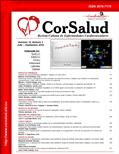Digoxin prescription in geriatric patients of the primary health care
Abstract
Introduction: Digoxin is one of the most used drugs in cardiovascular diseases, frequent in the geriatric patient, characterized by its narrow therapeutic margin.
Objectives: To characterize the prescription of digoxin and identify problems related to its prescription in geriatric patients.
Method: A descriptive and cross-sectional study was carried out on the use of drugs, indication-prescription type, in 23 patients with digoxin indication, treated at the Policlínico José Martí in Santiago de Cuba, from April to June 2017.
Results: In the case study, women (78.26%), ages between 70-74 years (26.08%), and patients with one or two associated diseases were more likely to use it. Diagnosis of cardiovascular diseases by Comprehensive General Medicine was prevalent, associated with a greater frequency of diuretics and antiplatelet drugs intervention group. The group with the lowest probability of survival was that of late treatment.
Conclusions: The prescription of digoxin may be considered as rational, although there is a possibility of drug interactions that could lead to toxic effects or therapeutic failure.
Downloads
References
1. González López-Varcárcel B, Cabeza Mora A, López Cabañas A, Díaz Berenguer JA, Álamo Santana F, Ortún Rubio V. Evolución de los estudios de utilización de medicamentos: del consumo a la calidad de la prescripción. Cuad Econ ICE. 2004;67:161-89.
2. Chivite D, Franco J, Formiga F. Insuficiencia cardíaca crónica en el paciente anciano. Rev Esp Geriatr Gerontol. 2015;50(5):237-46.
3. Romero CE. ¿Tantos estuvieron tan equivocados tanto tiempo? Rev Urug Cardiol. 2015;30(1):13-6.
4. Ortega López IL, Espinosa Durán R, Ibáñez Alcaraz M, Pelegrín Gamboa AL. Problemas asociados al uso de digoxina en pacientes geriátricos. Rev Cuba Farm [Internet]. 2014 [citado 27 Dic 2017];48(1):73-88. Disponible en: http://scielo.sld.cu/pdf/far/v48n1/far09114.pdf
5. American Geriatrics Society 2012 Beers Criteria Update Expert Panel. American Geriatrics Society updated Beers Criteria for potentially inappropriate medication use in older adults. J Am Geriatr Soc. 2012;60(4):616-31.
6. Moreno Pérez LM, Rodríguez Camiño R, Peraza Martínez E, Peraza Martínez C. Efectos de los medicamentos cardiovasculares sobre el globo ocular. CorSalud [Internet]. 2013 [citado 27 Dic 2017];5(1):72-83. Disponible en: http://www.corsalud.sld.cu/sumario/2013/v5n1a13/globocular.html
7. Salech F, Palma D, Garrido P. Epidemiología del uso de medicamentos en el adulto mayor. Rev Med Clin Condes. 2016;27(5):660-70.
8. Lo Presti A, Aular Y, Fernández Y, Carrillo M, Arenas E. Interacciones farmacológicas potenciales en pacientes con enfermedad cardiovascular polimedicados. Salus. 2015;19(2):13-9.
9. Di Somma S, Magrini L. Tratamiento farmacológico en la insuficiencia cardiaca aguda. Rev Esp Cardiol. 2015;68(8):706-13.
10. Samper Muarrak H, Pérez Muarrak D, Baró Rojas M, Sánchez Condales E, Reyes Quintana Y. Efectos del uso del carvedilol en la miocardiopatía dilatada en edad pediátrica. MediCiego [Internet]. 2015 [citado 27 Dic 2017];21(2). Disponible en: http://www.revmediciego.sld.cu/index.php/mediciego/article/view/406/769
11. Montoya JA, Arango C, Gaviria A, Mejía A, Carvajal JD, Hurtado JS, et al. Interacciones potenciales de fármacos antihipertensivos en un año de estudio de pacientes con hipertensión arterial atendidos en hospitales de 11 municipios del Departamento de Risaralda, Colombia. Gac Méd Caracas. 2013;121(2):132-41.
12. Calvo Barbado DM, Delgado Martínez I, Alfonso Orta I, Alonso Carbonell L, Alonso Galván P, Broche Villareal L, et al. Formulario Nacional de Medicamentos. La Habana: Editorial Ciencias Médicas; 2014.
13. Yancy CW, Jessup M, Bozkurt B, Butler J, Casey DE, Drazner MH, et al. 2013 ACCF/AHA guideline for the management of heart failure: a report of the American College of Cardiology Foundation/American Heart Association Task Force on Practice Guidelines. J Am Coll Cardiol. 2013;62(16):e147-239.
14. Scheuermeyer FX, Grafstein E, Stenstrom R, Christenson J, Heslop C, Heilbron B, et al. Safety and efficiency of calcium channel blockers versus beta-blockers for rate control in patients with atrial fibrillation and no acute underlying medical illness. Acad Emerg Med. 2013;20(3):222-30.
15. Ishikawa T. Pharmacological rate control therapy for atrial fibrillation. Nihon Rinsho. 2013;71(1):72-8.
16. Bonino A, Zócalo Y, Varela G, Calleriza F, Do Mato G, Reyes Caorsi W. Terapia de resincronización cardíaca: experiencia a diez años y análisis de la evolución clínica de los pacientes en un centro de nuestro país. Rev Urug Cardiol. 2014;29(2):173-180.
17. Whitbeck MG, Charnigo RJ, Khairy P, Ziada K, Bailey AL, Zegarra MM, et al. Increased mortality among patients taking digoxin – Analysis from the AFFIRM study. Eur Heart J. 2013;34(20):1481-8.
18. Turakhia MP, Santangeli P, Winkelmayer WC, Xu X, Ullal AJ, Than CT, et al. Increased mortality associated with digoxin in contemporary patients with atrial fibrillation: Findings from the TREAT-AF study. J Am Coll Cardiol. 2014;64(7):660-8.
19. Pastori D, Farcomeni A, Poli D, Antonucci E, Angelico F, Del Ben M, et al. Cardiovascular risk stratification in patients with non-valvular atrial fibrillation: the 2MACE score. Intern Emerg Med. 2016;11(2):199-204.
20. Joundi RA, Cipriano LE, Sposato LA, Saposnik G; Stroke Outcomes Research Working Group. Ischemic stroke risk in patients with atrial fibrillation and CHA2DS2-VASc Score of 1: Systematic review and meta-analysis. Stroke. 2016;47(5):1364-7.
Downloads
Published
How to Cite
Issue
Section
License
Authors who publish with this journal agree to the following terms:- Authors retain copyright and grant the journal right of first publication with the work simultaneously licensed under a Creative Commons Attribution License that allows others to share the work with an acknowledgement of the work's authorship and initial publication in this journal.
- Authors are able to enter into separate, additional contractual arrangements for the non-exclusive distribution of the journal's published version of the work (e.g., post it to an institutional repository or publish it in a book), with an acknowledgement of its initial publication in this journal.










